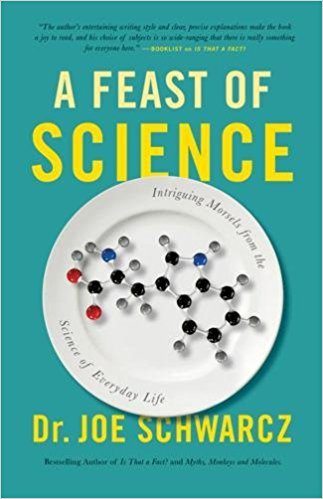
Did you know that Samuel Hahnemann, the misguided father of homeopathy, was an accomplished chemist who developed the first chemical test for arsenic? His test was applied in a poisoning trial in England: it was positive, but the color of the sample had deteriorated by the time it got to the jury, and they were not convinced. The failure to convict led John Marsh to develop a better test, the Marsh test, which became the standard for forensic science.
I didn’t know that, and I learned a lot of other fascinating facts from Joe Schwarcz’s latest book A Feast of Science: Intriguing Morsels from the Science of Everyday Life. Known as “Dr. Joe” from his long-running (38 years!) Montreal radio show The Dr. Joe Show, he is a chemistry professor and the Director of McGill University’s Office for Science and Society, an organization dedicated to demystifying science for the public. Among his many accomplishments are 22 books. This latest one is indeed a feast, offering tasty bite-sized morsels of chemistry, history, science, alternative medicine, critical thinking, and commentary on current trends. He has harsh words for Dr. Oz, Gwyneth Paltrow, Jenny McCarthy, Joseph Mercola, Suzanne Somers, and the Food Babe. Then he lists “outstanding websites” that offer reliable information about science. Science-Based Medicine heads his list: thanks for that, Dr. Joe
He says he feasts on science, but it can be hard to know which table to sit at, since the Internet and the media serve up a steady stream of dishes filled with toxic misinformation, and “Any twit can twitter.” He points out that anecdotal evidence is unreliable: it must be confirmed or disconfirmed by controlled trials. There are too many reports in the media claiming a scientific study has found “evidence” when all it really found was “possibility.”
He says responsible science reporting faces many challenges:
- The public wants simple solutions to complex problems.
- Scientists are not trusted but are perceived to be in the pockets of industry.
- Many scientists are not good communicators.
- Terms such as “alternative facts” have entered the public lexicon; there are no such things.
Today people are “more” informed about science but not “better” informed. Most people don’t understand the difference between “hazard” (the propensity to cause harm) and “risk” (the potential that it actually does harm, taking into consideration the type and extent of exposure and personal liabilities).
Claims are often wildly extrapolated from preliminary lab or animal studies. “A seed of truth is nurtured into a jungle of twaddle.” Cilantro apparently chelates heavy metals, but that doesn’t mean it is effective for detoxification in humans. Schwarcz says, “As usual, there is a kernel of truth to the claim, but that kernel is inflated with nonsense until it pops.” In general, the more claims for a product, the less likely any of them are true.
He describes how he first became interested in chemistry. When he read Jules Verne’s The Mysterious Island he took away the lessons that “Scientific ingenuity can solve a lot of problems, and phenomena that at first seem paranormal can turn out to be quite mundane as facts come to light.”
He addresses the “natural” fallacy:
Nature, albeit usually with significant help from chemists, is capable of furnishing us with useful medications. But that doesn’t mean we should swallow all claims about natural medicine hook, line, and sinker.
He repeats his mantra:
There are no safe or dangerous chemicals, only safe or dangerous ways to use them.
Example: Coumadin is a rat poison but it also saves human lives.
He makes a good point about homeopathy that I hadn’t heard before. In the dilutions used in homeopathic remedies, not only are there no molecules of the original substance, but there are no molecules of water that have ever been in contact with the original substance.
He tells the story of Mary Toft, who fooled even the best doctors into believing that she was giving birth to rabbits. He comments, “Education wasn’t then, and isn’t now, a vaccination against folly.” Not even Nobel Prize winners are exempt from folly. He chastises Linus Pauling for offering a correlation between rising vitamin C sales and declining rates of heart disease as evidence that vitamin C prevents heart disease. Pauling even went on to recommend large doses of vitamin C and lysine to treat heart disease. He should have known better: correlation doesn’t equal causation.
Schwarcz says petroleum products should be considered organic, since petroleum is a natural decomposition product of plant and animal matter acted on by soil-dwelling microbes.
In a long series of short but tasty 2- to 4-page offerings he covers a variety of topics, too many to list here. Extending the analogy of a feast, I’ll just provide a few amuse-bouche treats to whet your appetite for reading the book:
- During the Great Plague in seventeenth century London, smoking was thought to be protective and even children were forced to smoke tobacco, with threats of being whipped if they didn’t.
- Morphine was the first active ingredient to be isolated from a medicinal plant, by the German pharmacist Friedrich Wilhelm Sertürner, in the early nineteenth century.
- I knew the original formula for Coca Cola contained cocaine, but I didn’t know the original 7-Up contained lithium, a chemical with antidepressant effects.
- Condoms were originally marketed for preventing syphilis, not for contraception.
- The song “A Spoonful of Sugar” in the movie Mary Poppins was inspired by the fact that the writer’s children were given oral polio vaccine dripped onto sugar cubes.
- There is a shampoo that contains bull semen to “leave hair with a brilliant sheen that no other substance can match.” Sounds like a lot of bull to me.
There are many, many more delectable historical tidbits in this banquet. And there are more meaty subjects: up-to-date information on things like telomeres and longevity, cleanses, bedbugs, GMOs, and nutritional guidelines. You are all invited to partake.

